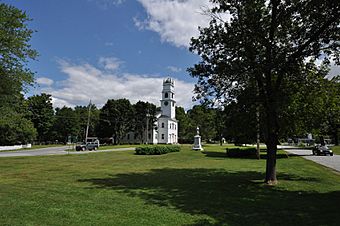Lyme Common Historic District facts for kids
Quick facts for kids |
|
|
Lyme Common Historic District
|
|

Common with Congregational Church
|
|
| Lua error in Module:Location_map at line 420: attempt to index field 'wikibase' (a nil value). | |
| Location | Dorchester Rd., John Tomson Way, On the Common; Pleasant and Union Sts., E. Thetford Rd., Main and Market Sts., Lyme, New Hampshire |
|---|---|
| Area | 80 acres (32 ha) |
| Architect | Multiple |
| Architectural style | Greek Revival, Federal |
| NRHP reference No. | 88001435 |
| Added to NRHP | September 1, 1988 |
The Lyme Common Historic District is a special area in Lyme, New Hampshire. It's like a time capsule showing what a village center looked like a long time ago. This district was created in 1781. It has sixty old buildings around a central town common and along the nearby streets.
This historic area is a great example of a 19th-century village that has been kept in really good condition. Because it's so well-preserved, it was added to the National Register of Historic Places in 1988.
Contents
Exploring the Lyme Common Historic District
The main part of this 80-acre district is the town common. This is a large, flat, grassy area that stretches from east to west. It's just south of Main Street, which is also called New Hampshire Route 10.
The most important building you'll see at the east end of the common is the First Congregational Church. The district also includes parts of NH 10 to the north and a bit beyond the common to the south.
How Lyme Common Began
The town common started to take shape in 1781. This was when a meeting house was built there. A meeting house was a very important building where people gathered for church and town meetings. This building is now known as the Nichols Store.
Because the meeting house was built here, this village (then called "Lyme Plain") became more important than Lyme Center. Lyme Center is about two miles to the east and was closer to the town's geographic center.
Growing with New Buildings
After the common was laid out, many new houses were built between 1790 and about 1820. These homes were built in popular styles of the time, like Federal and Greek Revival architecture.
The First Congregational Church, which you can still see today, was built around 1810. At the same time, long sheds for horses were built behind the church. These horse sheds are thought to be the longest row of their kind still existing in New Hampshire!
More Buildings and Modern Touches
Another big building boom happened in the area between 1840 and 1865. These were the years leading up to the American Civil War.
You can also find some buildings from the 20th century in the Colonial Revival style. Even newer buildings or replacements have been designed to fit in with the older styles. This helps keep the historic look of the district.

